
by Ecoziva (Brazil) | Apr 7, 2014 | Brazil, Environment, Millennium Development Goals, Nature, Social Good, Uncategorized, World Interviews, World Motherhood
This post follows up on WMB’s eight-month campaign to raise awareness for the eight Millennium Development Goals (MDGs). In this post, we reflect on MDG #7: Ensure Environmental Sustainability. The following is an interview with Silvio Rocha Sant’Ana, president of the Esquel Group.

World Moms Blog: What are some examples of how the Esquel Group supports environmental sustainability?
SRS: We have been working with other civil society organizations (CSOs) and governmental institutions in the fields of adapting to climate change, combating desertification (in Northeast Brazil), designing proposals for public policies on these matters, and dialoguing directly with financial agencies (public and private) in order to make them more adjusted to sustainability criteria.
How can mothers help support your organization in achieving MDG #7?
SRS: It is a new question for me. Thinking aloud: mothers have a fine sense of survival and can operate in adverse conditions much better than men. We work with a lot of very poor mothers (especially at the Pastoral da Criança and the microfinancing project). The way they think (and act), their relationship to the environment, the ability to allocate resources in the difficult social conditions they live in – all of this is a continuous lesson we can learn from. In fact, it would be interesting to have an environment that would enable us to maximize their teachings and contributions.
What countries does the Esquel Group mainly work in?
Silvio Rocha Sant’Ana: Esquel is currently active in the USA, Ecuador and Brazil. Each organization is independent, and defines its own agenda; we have common concerns and themes.
How does Esquel Group bridge the gap of joining people in economic development?
SRS: We have developed many activities in different fields. In Brazil we have focused in the Northeast region (where there are severe environmental and social restrictions), on children aged 0-6 years in Brazil, and in the field of technical support. We also work closely with the Pastoral da Criança, including microfinancing for employment and income generation (mainly for women).
What is the Esquel Task Force?
SRS: The Esquel Task force is an initiative from the USA Esquel Group and fosters dialogue, advocacy and lobbying among American and Latin American organizations.
Is there a specific example in Brazil where Esquel made a big impact when it came to the environment?
SRS: There is a very famous Project in Brazil called “1 million cisterns” – tanks to collect rain water in the semi-arid region of Brazil. Esquel has had a leading role in building up this project and the related public policies. It is considered an extraordinary and successful case of public-private cooperation and has mobilized, to date, more than US$200 million. It is a project managed entirely by CSOs and its main goal is to create a new pattern of social wellbeing in the semi-arid region, with full respect to environmental conditions.
What would you say are the greatest environmental issues facing Brazil today?
SRS: Adaptation to climate changes and associated cultural adjustments within an “economic and social environment”, which favors “economic growth” above all things (including social and environmental welfare).
What is the unifying theme of all Esquel’s activities worldwide?
SRS: The unifying theme of Esquel’s activities is the strengthening of civil society, specifically citizen organizations that further democracy.
This is an original interview post for World Moms Blog by our writer in Brazil, EcoZiva.
For more about the Esquel Group, visit their website at http://esquel.org/.
Eco, from the greek oikos means home; Ziva has many meanings and roots, including Hebrew (brilliance, light), Slovenian (goddess of life) and Sanskrit (blessing). In Brazil, where EcoZiva has lived for most of her life, giving birth is often termed “giving the light”; thus, she thought, a mother is “home to light” during the nine months of pregnancy, and so the penname EcoZiva came to be for World Moms Blog.
Born in the USA in a multi-ethnic extended family, EcoZiva is married and the mother of two boys (aged 12 and three) and a five-year-old girl and a three yearboy. She is trained as a biologist and presently an university researcher/professor, but also a volunteer at the local environmental movement.
More Posts

by Karyn Wills | Feb 10, 2014 | 2014, Awareness, Being Thankful, Brothers, Childhood, Education, Family, Food, Health, Life Balance, Life Lesson, Milestones, Motherhood, Nature, New Zealand, Nutrition, Older Children, Parenting, Relationships, Traditions, Travel, Vacationing, World Motherhood
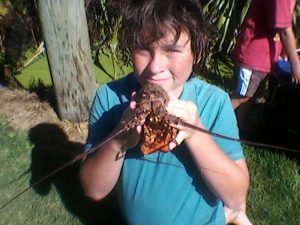 One of my enduring memories of childhood is of trapsing over paddocks, up and down hills, in gumboots too big for my feet picking mushrooms or blackberries. Eventually getting sore heels and aching legs. Eventually filling buckets and ice-cream containers with food.
One of my enduring memories of childhood is of trapsing over paddocks, up and down hills, in gumboots too big for my feet picking mushrooms or blackberries. Eventually getting sore heels and aching legs. Eventually filling buckets and ice-cream containers with food.
Probably scrapping with my sisters. Probably moaning about having to do so. Definitely covered in blackberry juice and scratches on blackberry days. Definitely not impressed by having to pick mushrooms, which I didn’t like to eat.
This summer holiday, my boys got to harvest their own food. Not blackberries and mushrooms, though. They got to harvest seafood.
Tuatua (too-ah-too-ah) are a shellfish. The children love to collect them. We go out at almost low-tide or just after low-tide in thigh-high water. We do the Twist. Our feet sink into the wet sand and feel around for something hard. When we find one, we reach down and pick it up with our hands.
Sometimes, we are side-swiped by a wave. Sometimes, we pick up a round hard sea-biscuit instead. At times, instead of the Tuatua-Twist there is a Crab-Bite-Leap with occasional bad-language. There is almost always laughter and a competition to see who can find the most. This year, the boys and their cousins also took responsibility for collecting fresh seawater twice a day, to keep the Tuatuas in, while they spat out all the sand inside their shells. They kept them cool in the fridge and, when they were finally cooked, the children ate them: some with gusto, others not so much. To me, they taste a bit like chewy seawater…
Our eldest son, 12 year-old Joe, with his 13 year-old girl cousin, Billie, trapped their own crayfish.
Crayfish are related to rock-lobster and, in our extended family, are usually trapped off-shore and by boat, or dived for with scuba-gear and tanks. Joe and Billie had kayaked out around a small peninsula and discovered an old craypot on the rocks. They dragged it out of the sea and managed to convince their fathers to repair it. They then kayaked it out again and dropped it on a good rocky spot.
Each day they went out to check their pot, just as the adults do the other craypots. The first day they caught – seawater. The second day they caught – seawater. The third day they were a bit fed up and otherwise occupied, so didn’t go out. The fourth day or maybe it was the fifth, Billie was out fishing and Joe went out alone to see what was there and to bring the pot in for good. He was very excited to discover they had caught a legal-sized cray! Yes, duly cooked and eaten.
In these days where many children don’t know that carrots grow in the ground or that their meat comes from a real animal, I love that our boys are sometimes involved in the process of food-collection and the processes of preparing it for a meal. I know that these are the Good Old Days and these moments will create some of their childhood memories.
Do your children do similar things you did as a child? Are they involved in collecting or harvesting their own food?
This is an original post to World Moms Blog from our writer in New Zealand and mum of three boys, Karyn Van Der Zwet.
The image used in this post is credited to the author.
Karyn is a teacher, writer and solo mother to three sons. She lives in the sunny wine region of Hawke’s Bay, New Zealand in the city of Napier.
More Posts

by Karyn Wills | Sep 2, 2013 | Brothers, Childhood, Education, Family, Life Balance, Motherhood, Nature, New Zealand, Parenting, World Moms Blog, World Motherhood, Younger Children
 When my boys were learning to roll over, I never stopped them from bumping their heads on the floor. We had carpet, vinyl and tiles, and they had access to all of those surfaces and often rolled from one to another. By the end of the first week there had been a few bangs and tears, but nothing that couldn’t be sorted with a cuddle and rock in my arms – and they had all learned to lift their heads up as they rolled.
When my boys were learning to roll over, I never stopped them from bumping their heads on the floor. We had carpet, vinyl and tiles, and they had access to all of those surfaces and often rolled from one to another. By the end of the first week there had been a few bangs and tears, but nothing that couldn’t be sorted with a cuddle and rock in my arms – and they had all learned to lift their heads up as they rolled.
I didn’t really think about this approach much but assigned it to other events as they grew. I did things like: holding my hand over the corner of a table when they toddled by; casually pointing out the floor was wet after I had mopped it; physically turning them around as they crawled down our concrete steps, so they could get down backwards; making sure they had one bed they could bounce on; and showing them how to get out of the trees they had climbed. As a result by the age of four they could all do things like; cut food and sticks using sharp knives, get themselves out of tight spots, and use a battery-drill and an iron without hurting themselves. By then they knew the difference between tools and toys.
I never pushed them or even encouraged them to do these things; I just (mostly) allowed them to as they were inclined to, taught them a few tricks, and turned up with plasters and cuddles when things didn’t go according to plan.
I have come to accept that children are driven to seek a certain amount of danger and I have found the more I have allowed my boys to set the pace of their ‘dangerous’ behaviours the more self-assured and capable they have become, and more aware of the risks NOT to take.
They occasionally have bitten off more than they could chew (when four years old, our eldest decided to ride around our block alone on his bike, he didn’t want to do that again for another two years) but most often than not they have taken small steps, fast. I often see children who have not been allowed to take the same small steps and they seem, to me, to be either too timid to take any chances or they over estimate their abilities to truly dangerous levels.
There seem to be two strong opposing forces in New Zealand parenting at the moment. One in which ‘safety first’ is the catch phrase, and the other which emphasises the importance of children being allowed to take measured risks. It seems I’ve ended up on one side of this debate without even trying, but now am really pleased that I have taken the approach I have taken.
What’s the approach to danger in your house? Do you think children need to be kept safe or that they need to learn to manage danger?
This is an original post to World Moms Blog from our writer in New Zealand, Karyn Van Der Zwet
The photograph used in this post is credited to the author.
Karyn is a teacher, writer and solo mother to three sons. She lives in the sunny wine region of Hawke’s Bay, New Zealand in the city of Napier.
More Posts

by Ecoziva (Brazil) | Aug 12, 2013 | 2013, Being Thankful, Birthing, Brazil, Child Care, Contraception, Family, Husband, Kids, Life Balance, Life Lesson, Marriage, Milestones, Motherhood, Nature, Parenting, Pregnancy, Working Mother, World Motherhood, Younger Children
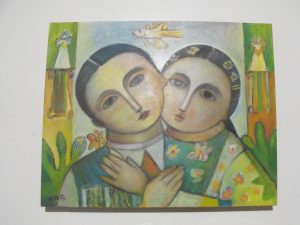 It is no secret to those who know me that marrying and having kids wasn’t exactly part of my life plan. I thought someday I might want to, but up to my 24th year of age – which is when I got pregnant with our first child – the feeling hadn’t come up. My husband, on the other hand, wanted to marry and have a bunch of kids from the time he was a teenager!
It is no secret to those who know me that marrying and having kids wasn’t exactly part of my life plan. I thought someday I might want to, but up to my 24th year of age – which is when I got pregnant with our first child – the feeling hadn’t come up. My husband, on the other hand, wanted to marry and have a bunch of kids from the time he was a teenager!
After a lot of inner work and, above all, after seeing our son’s face for the first time, I fell in love with motherhood. The issue then became: how many children would we actually have? What exactly would be the average between my hesitance and my husband’s “as-many-as-I-can-convince-her-to”?
The answer was part instinct, part serendipity. As a wedding gift, one of my husband’s college professors had a painting made especially for us. The painter did not know us, so (as the story goes) the professor described us as two young, nature-loving, alternative creatures. The piece that resulted – which now hangs right here behind me – portrays a solemn-looking, round-faced couple that is so close they could be Siamese twins. The left hand of each rests on the other’s heart. The girl wears a flower printed dress, has flowers in her hair and a single flower in her hand. The guy wears a suit of sorts. On the side of each of their shoulders is a green, succulent plant, and above each plant is an angel resting on what seems like a marble pillar, one blue, one yellow. Above the couple is a yellow, flying fish.
I was five months pregnant then and had just found out the baby was a boy. The name we chose means “he who tills the earth”. I don’t know who said it first, but we started joking that the blue angel was our boy, the yellow angel was our future second child (a daughter whose name would mean “lady of the waters” in an Indigenous language) and the flying fish would be our youngest (a little boy whose name – a reference to a famous Greek character – would mean “he who balances himself in the air”).
Coincidence or not, here we are almost nine years later with the three of them, born in that order and aged nearly nine, two and a half, and five months. And with the added bonus that both our lady of the waters and our little “flying fish” were born in our tub, to the sign of Pisces!
Having gone through a particularly difficult pregnancy this last time, I constantly tried to convince my husband to undergo a vasectomy. He, however, did not even want to hear about it (like many men I know, he has a huge needle phobia!).
Later, while I was in labor, he said he would do it (talk about good timing!). At that moment I was ecstatic, yet after the baby was born I began to question myself about our decision. I look at that cute little baby (it doesn’t help that he is so calm and sleeps so well!!) and think wistfully, “Oh my, this is the last baby in the house until we have grandkids!” Or now, as the time approaches to start introducing food in addition to nursing, “This is the last time I will be able to smell this pure breast milk breath all the time!” And so on…
My husband of course took advantage of all this and decided to postpone the vasectomy for another two years until I am absolutely sure.
When I stop to really ponder, three seems like a perfect number considering our life style and the way we raise our kids. For instance, we enjoy working from home as much as possible and choose to rely on as little outer help as possible; all of this gets harder with more kids.
Of course, if we “accidentally” did have more children we would find a way. On the other hand, if my husband did undergo a vasectomy and then we later changed our mind, we could adopt (which was a possibility we had considered before having our third child).
Do I really want more kids or am I just attached to this cute baby phase? The truth is, I don’t really know the answer right now! Let’s see what the future has in store…
And you, how many kids do you have? Was it a planned number or did it just happen? How did you decide? Please share your story!
This is an original post to World Moms Blog from our enviro-mama and mother of three in Brazil, EcoZiva.
The photograph used in this post is of the referenced painting commissioned for the author and her husband. It was submitted by the author.
Eco, from the greek oikos means home; Ziva has many meanings and roots, including Hebrew (brilliance, light), Slovenian (goddess of life) and Sanskrit (blessing). In Brazil, where EcoZiva has lived for most of her life, giving birth is often termed “giving the light”; thus, she thought, a mother is “home to light” during the nine months of pregnancy, and so the penname EcoZiva came to be for World Moms Blog.
Born in the USA in a multi-ethnic extended family, EcoZiva is married and the mother of two boys (aged 12 and three) and a five-year-old girl and a three yearboy. She is trained as a biologist and presently an university researcher/professor, but also a volunteer at the local environmental movement.
More Posts
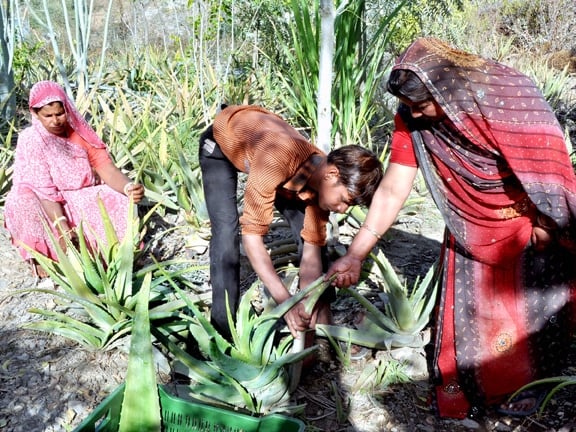
by Purnima Ramakrishnan | Jul 23, 2013 | Casting a Wider Net, Economy, Education, Feminism, Government, Human Rights, Humanity, India, Inspirational, International, Motherhood, Nature, Purnima, Social Good, The Alchemist, United Nations, Women's Rights, World Moms Blog, World Voice
A couple of weeks ago, we featured a remote village, Piplantri (Western India) on the Gates Foundation. Piplantri is a model village, whose actions of change have been very well received all over India.
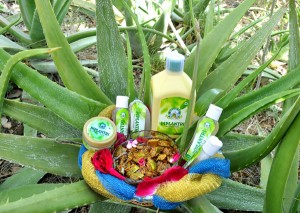
Aloe Vera products from the small scale industries
They plant 111 trees for every girl child who is born, create a fixed deposit of INR 31,000 (approx. USD 620) in her name which attains maturity when she is 18 years old and chalk up a legal agreement between the parents of the girl child and the government that they won’t get their girls married off before she is 18 years old. They also have Aloe Vera industries in which the women of the village are employed. So they have achieved MDGs #3 (promote gender equality and empower women), #4 (reduce child mortality), and #7 (ensure environmental sustainability) at one go. Today on the blog, I would like to introduce Mr. Shyam Sundar Paliwal and his wife, Anita, who were the pioneers of this change action in their village. Anita is 42 years old, and she got married after she finished her 12th grade. It was an arranged marriage and the couple were happy.
Their first daughter Kiran was 18 years old when she passed away. She died due to dehydration. That was the turning point in their life, and they vowed to make lives of others happy.
They also have another daughter Hemanshi (22) and a son Rahul (15) who is in 10th grade. Hemanshi is married and has a child, too.
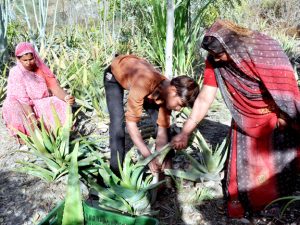
The women of the village tending Aloe Vera
Anita recalls that when she came to her in-laws place after she got married, the first lesson she received from her father-in-law was to plant banana saplings such that they bear fruits during the rainy season and then plant mango saplings around the banana trees. Banana trees absorb water during the monsoon and transfers this water to the mango trees through its roots during the arid summer season. She says she has stuck to this piece of advice to date in her village and ensured that her villagers follow such age-old farming wisdom.
Anita, who is the wife of the ex-sarpanch (ruling political head) of the village, Piplantri, is a very active community member. She is a Zila Parishad Member (Elected person of the district council). Her husband has always been supportive of her as a woman and wants her to do her best for her villagers. He has never restricted her in any way. Though she is more educated than him, he has never been jealous of her, but has only encouraged her and furthered her growth and development as an active member of their society and community. She says, if only all women of the world gets a husband like Shyam, the women of the world will be better off and we would not be speaking of women’s rights here.
Shyam Sundar won the panchayat elections in 2005 and he says he first wanted the people who worked in the government offices to be comfortable. He installed the first AC in the office, brought in some comfortable furniture and ensured that people in all echelons of the society were treated equally. (In rural India, at times, the upper caste people are given more respect and sit on chairs, whereas the lower caste people are treated shabbily and sit down on the floor. Read more about the Evils of Caste system in India here). He said, he worked on the psychology of the ruling body to make them happy and comfortable. He says, only if they are happy, they would start working on reform measures and help provide for the remaining villagers. He, at his own expense, made the offices a comfortable place to work and conducive to provide better results.
He started small. In this difficult water shortage era, he diverted the waste water from all houses/offices towards the fields. Better water conservation was ensured. If waste water does not stagnate anywhere, there would be no mosquitoes and no dengue and fewer diseases. So, he solved primarily problems with simple, cost-effective solutions.
He installed drinking RO water systems in schools. Brought in furniture for the students and made the public schools better than the expensive private schools. People started flocking towards government schools. He raised awareness slowly and in a small way, which evolved out.
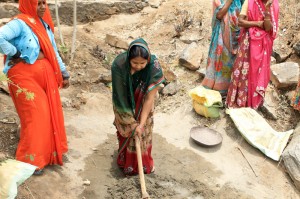
Mrs. Anita Paliwal working on the Water Harvesting Structure
He started rain water harvesting with the help of government. He built canals. He used the women of the village who were unemployed. To the left is a picture of Anita, who at times does not hesitate to get into the fields with a mean sickle. She and her husband were instrumental in starting the water harvesting structure of the village. In most of his welfare activities 90% of the employed are women and 10% alone are men. Women of the village have been blessed indeed to have him there, says Anita. In addition to 25,00,000 Aloe Vera plants, there are 10,000 rose shrubs which are also used in small-scale industries for toiletries and medicinal supplements. Women are employed in all of these schemes.
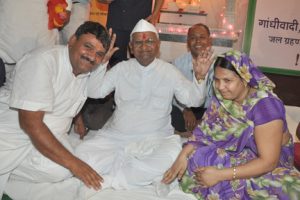
Mr. Shyan Sundar Paliwal and Mrs. Anita Paliwal with Anna Hazare
He started the Kiran Nidhi Yojna with the 76-year-old International Social Activist, Anna Hazare to ensure that no girl child is married off before 18 years old. This man who himself did not study in a college, ensures that all girl children in his village get a college degree. He also nudges the parents to get their girls married off in collective wedding, so that money is conserved and better utilised for other public welfare schemes or for their own savings. This scheme also granted government land to the parents in return for planting 111 trees on the birth of their daughter in that land, and tending to it to fruition before their girl child is 18 years old. On the death of any community member, the family is requested to plant trees again.
He says this again works on their psychology. The girl children treat the trees as their own brothers and sisters. After all, the saplings were planted on the day of their birth. And the parents get emotionally attached to the trees which came into existence on the day their family member was born or died. They then take care of it as a family member, and would under no means cut it down. He says, it is all in the hearts of the people. If people get involved with their hearts, anything is possible. He made people to get emotionally attached to nature and trees and the earth.
I learnt something new from Anita and Shyam that day – Ecofeminism. It is such a beautiful concept. Women and nature have been connected since time immemorial and this couple have harnessed it.
After all, he who was not highly educated could work on such things and make that beautiful village into a heaven, he says, the whole world could change too. And we would have no need to talk about the MDGs or uplifting of any downtrodden society/community.
When asked how he felt when his village was showcased by the Gates Foundation on their Blog, he gushed with happiness and pride. The district collector and Panchayat officials were so excited, too, he said. But his only complaint was that he could not get a hard copy of the magazine which he could show his villagers. He is so proud like a father, like the father of the heaven he created.
He also invites donation to his Kiran Yojna Scheme for the fixed deposit of INR 31000 of every girl child born in his village. He invites the contributors, readers and fans of World Moms Blog to make a trip to Piplantri. He wants people to embrace such change and for them to build upon it to suit their own society, and community.
This is an original post to World Moms Blog by Purnima, our Indian mother writing from Chennai, India. Her contributions to the World Moms Blog can be found here. She also rambles at The Alchemist’s Blog.
Photo credit to Piplantri.com
What do you think about the traditions put in place to support girls and women in the community of Piplantri?

by Karyn Wills | Mar 6, 2013 | Family, Gardening, Nature, New Zealand, Uncategorized
 We have a wonderful cycling and walkway that encircles most of Napier, some tracks wander along the beach and some meander through the countryside. Along the water front, there are strategically placed water fountains from which fresh, clean water gushes at the push of a button. And we never question its availability.
We have a wonderful cycling and walkway that encircles most of Napier, some tracks wander along the beach and some meander through the countryside. Along the water front, there are strategically placed water fountains from which fresh, clean water gushes at the push of a button. And we never question its availability.
18 months ago, our family moved out of town. We now have a 15 minute drive to reach civilisation, and we have to collect and store our own water. This shouldn’t be a problem – we have three large water tanks and 2011/2012 we had a wet summer and a decently wet winter. But it has been a problem.
Unbeknown to us, the two larger tanks had a plumbing issue: no matter how much it rained they were either maintaining the same level of water or the water level was reducing. Eventually, when we realized the neighbours had a lovely green patch of grass just near one of our troughs, we found the leak. That discovery happened in October last year, around the same time the drought began. (more…)
Karyn is a teacher, writer and solo mother to three sons. She lives in the sunny wine region of Hawke’s Bay, New Zealand in the city of Napier.
More Posts
























